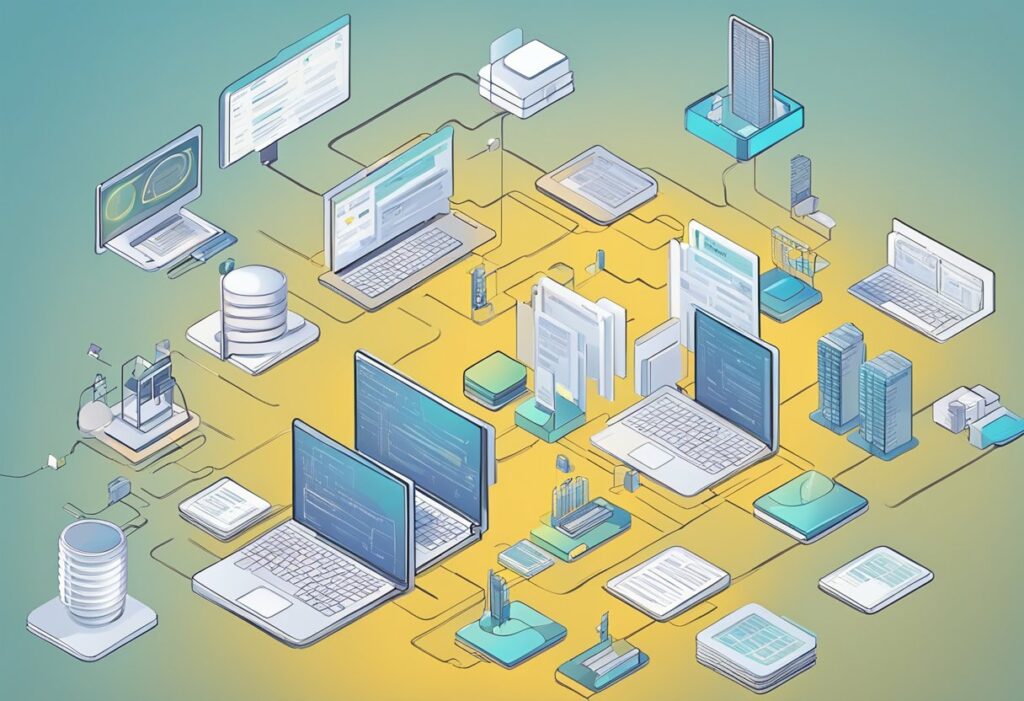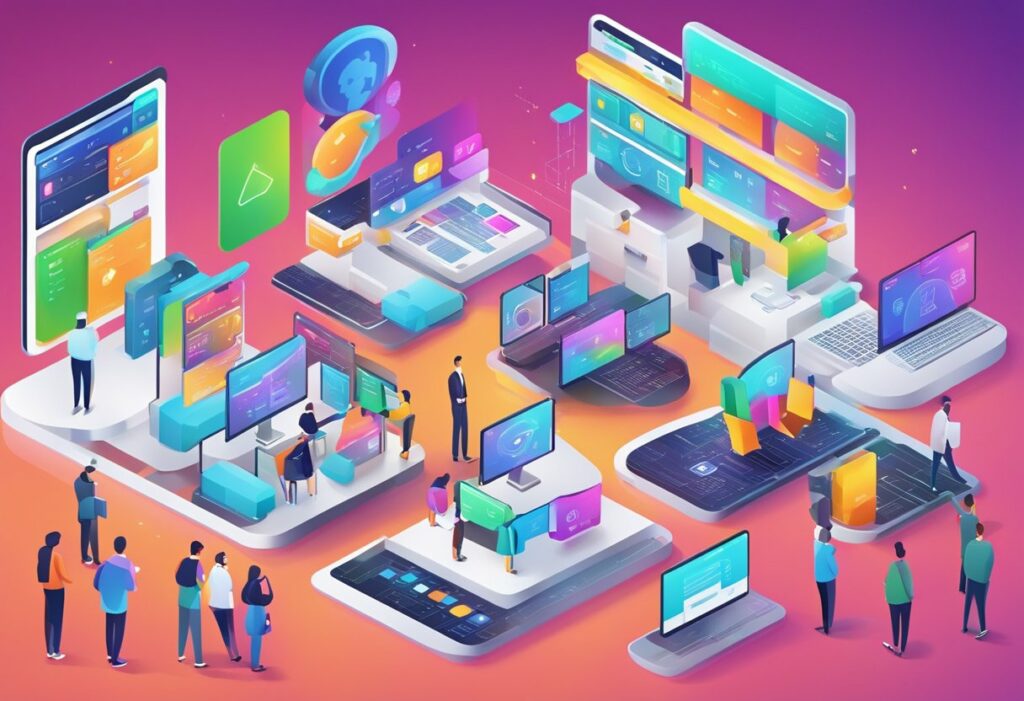Artificial Intelligence (AI) has become a rapidly growing field in recent years, with the development of new technologies that are changing the way we live and work. As AI continues to evolve, more and more businesses are adopting AI tools to streamline their operations, improve their customer experience, and gain a competitive edge in the market.
There are a variety of popular AI tools available today that can help businesses automate tasks, analyze data, and make more informed decisions. One popular tool is ChatGPT, an AI chatbot that uses a large language model to provide detailed responses to customer inquiries in natural, human-like language. With over 14.6 billion visits to its website in 2024, ChatGPT has become a go-to tool for businesses looking to improve their customer service.
Another popular AI tool is OpenAI, which offers an API that businesses can use to build custom AI tools for their specific needs. OpenAI has been used by a variety of businesses, from translation apps and mapping software to e-commerce sites and social media platforms. With its powerful machine learning capabilities, OpenAI is a versatile tool that can help businesses automate a wide range of tasks and gain valuable insights from their data.
Machine Learning Frameworks

When it comes to machine learning, frameworks are essential tools for data scientists and machine learning engineers. They provide a structured environment for developing, training, and deploying machine learning models. Here are some of the most popular machine learning frameworks:
TensorFlow
TensorFlow is an open-source machine learning framework developed by Google. It is one of the most popular frameworks for deep learning and is used by many companies and researchers. TensorFlow provides a flexible and efficient platform for building and training machine learning models. It supports a wide range of languages, including Python, C++, and Java.
Scikit-Learn
Scikit-Learn is a popular Python library for machine learning. It provides simple and efficient tools for data mining and data analysis. Scikit-Learn is easy to use and has a wide range of algorithms for classification, regression, clustering, and dimensionality reduction. It is widely used in academia and industry for machine learning projects.
PyTorch
PyTorch is an open-source machine learning framework developed by Facebook. It is widely used for deep learning and provides a flexible and efficient platform for building and training machine learning models. PyTorch supports dynamic computation graphs, which makes it easy to build complex models. It is also easy to use and has a large community of developers.
Keras
Keras is a high-level neural networks API written in Python. It is easy to use and provides a simple and intuitive interface for building and training machine learning models. Keras supports both convolutional and recurrent neural networks and is widely used for deep learning projects. It can run on top of TensorFlow, Theano, and CNTK.
In conclusion, machine learning frameworks are essential tools for data scientists and machine learning engineers. They provide a structured environment for developing, training, and deploying machine learning models. TensorFlow, Scikit-Learn, PyTorch, and Keras are some of the most popular machine learning frameworks.
Natural Language Processing

Natural Language Processing (NLP) is a subfield of artificial intelligence that focuses on enabling machines to understand and interpret human language. NLP has become increasingly popular in recent years due to its ability to help businesses make sense of the vast amounts of unstructured data generated by humans.
NLTK
The Natural Language Toolkit (NLTK) is a popular open-source NLP library that is widely used in academia and industry. NLTK provides a wide range of tools for tasks such as tokenization, stemming, part-of-speech tagging, and named entity recognition. The library also includes a large collection of corpora and pre-trained models that can be used for a variety of NLP tasks.
spaCy
spaCy is another popular open-source NLP library that is known for its fast and efficient processing speed. spaCy provides a wide range of tools for tasks such as tokenization, part-of-speech tagging, dependency parsing, and named entity recognition. The library also includes pre-trained models for a variety of languages, making it a popular choice for multilingual NLP applications.
GPT-3
GPT-3 (Generative Pre-trained Transformer 3) is a state-of-the-art language model developed by OpenAI. GPT-3 is capable of generating human-like text, answering questions, and even completing tasks such as writing code or composing music. The model has been trained on a massive amount of data and has been shown to outperform humans on a variety of language tasks.
BERT
Bidirectional Encoder Representations from Transformers (BERT) is another state-of-the-art language model developed by Google. BERT is capable of understanding the context of words in a sentence, allowing it to perform tasks such as sentiment analysis, question answering, and text classification. The model has been pre-trained on a large corpus of text and can be fine-tuned for specific NLP tasks.
Overall, these NLP tools and platforms are helping businesses make the most of AI by enabling machines to process and understand human language. Whether you are working with large amounts of unstructured data or building a chatbot, these tools can help you get the job done quickly and efficiently.
Computer Vision

Computer vision is an essential field of artificial intelligence that enables machines to interpret and understand the visual world. In this section, we will discuss some of the most popular computer vision tools that are widely used in the industry.
OpenCV
OpenCV is an open-source computer vision library that provides a wide range of algorithms and functions for image and video processing. It is written in C++, but it also has interfaces for Python, Java, and MATLAB. OpenCV is widely used in the industry for various applications such as object detection, face recognition, and image segmentation. It is also compatible with various platforms such as Windows, Linux, and macOS.
YOLO
YOLO (You Only Look Once) is a real-time object detection system that uses deep learning algorithms. It is one of the most popular object detection systems due to its high accuracy and fast speed. YOLO can detect multiple objects in an image and classify them into different categories. It is widely used in various applications such as self-driving cars, surveillance systems, and robotics.
FastAI
FastAI is a deep learning library that provides a high-level interface for building and training neural networks. It is built on top of PyTorch and provides various pre-trained models for computer vision tasks such as image classification, object detection, and segmentation. FastAI is designed to be easy to use and provides various features such as data augmentation, transfer learning, and model interpretation. It is widely used in the industry for various applications such as medical imaging, autonomous vehicles, and robotics.
In conclusion, computer vision is a critical field of artificial intelligence that enables machines to interpret and understand the visual world. OpenCV, YOLO, and FastAI are some of the most popular computer vision tools that are widely used in the industry.
Data Analysis and Visualization

Data analysis and visualization are two crucial aspects of any data-driven organization. With the advent of AI, these processes have become more efficient and productive. In this section, we will discuss some of the most popular AI tools for data analysis and visualization.
Pandas
Pandas is a popular open-source data analysis library for Python. It is widely used for data manipulation and analysis. Pandas provide a wide range of functions and tools for data cleaning, transformation, and analysis. It can handle various types of data, including CSV, Excel, SQL databases, and more.
Matplotlib
Matplotlib is a powerful data visualization library for Python. It provides a wide range of tools for creating high-quality plots, charts, and graphs. Matplotlib is highly customizable and can be used to create various types of visualizations, including line plots, scatter plots, bar plots, and more.
Seaborn
Seaborn is a Python data visualization library based on Matplotlib. It provides a higher-level interface for creating complex statistical visualizations. Seaborn is easy to use and provides a wide range of tools for creating various types of plots, including heatmaps, pair plots, and more.
In conclusion, Pandas, Matplotlib, and Seaborn are some of the most popular AI tools for data analysis and visualization. These tools provide a wide range of functions and tools for data manipulation, cleaning, transformation, and analysis, as well as for creating high-quality plots, charts, and graphs.
Speech Recognition

Speech recognition is a technology that allows machines to recognize and interpret human speech. It has become increasingly popular in recent years, and there are now several AI tools available that can perform speech recognition tasks with high accuracy. In this section, we will discuss two popular speech recognition tools: Wit.ai and DeepSpeech.
Wit.ai
Wit.ai is a natural language processing (NLP) platform that provides speech recognition capabilities. It is a cloud-based platform that uses machine learning to understand and interpret human speech. Wit.ai can be used to build voice-controlled applications, chatbots, and other AI-powered tools that require speech recognition capabilities.
One of the key features of Wit.ai is its ability to recognize and understand natural language commands. This means that users can interact with applications using their voice, without having to use specific commands or phrases. Wit.ai also provides a simple API that developers can use to integrate speech recognition capabilities into their applications.
DeepSpeech
DeepSpeech is an open-source speech recognition engine developed by Mozilla. It is based on machine learning algorithms and uses deep neural networks to perform speech recognition tasks. DeepSpeech can be used to transcribe audio files, perform voice searches, and interact with voice-controlled applications.
One of the key advantages of DeepSpeech is its accuracy. It has been shown to perform as well as or better than commercial speech recognition engines. DeepSpeech is also highly customizable, which means that developers can fine-tune the engine to meet their specific needs.
In conclusion, speech recognition is a powerful technology that has many practical applications. Wit.ai and DeepSpeech are two popular AI tools that provide speech recognition capabilities. Developers can use these tools to build voice-controlled applications, chatbots, and other AI-powered tools that require speech recognition capabilities.
AI Platforms

AI platforms are powerful tools that allow developers and data scientists to build, train, and deploy machine learning models. These platforms offer a range of capabilities, from data preparation and model selection to deployment and monitoring. Here are a few popular AI platforms:
Google AI Platform
Google AI Platform is a cloud-based platform that offers a range of tools for building and deploying machine learning models. It includes tools for data preparation, model training, and deployment, as well as tools for monitoring and managing models in production. Google AI Platform also integrates with other Google Cloud services, such as BigQuery and Cloud Storage.
Some of the key features of Google AI Platform include:
- AutoML: a suite of tools for automating the machine learning process, including data preparation, feature engineering, and model selection.
- TensorFlow: a popular open-source machine learning library that is supported by Google.
- Kubeflow: an open-source platform for building and deploying machine learning workflows on Kubernetes.
IBM Watson
IBM Watson is a suite of AI tools and services that are designed to help businesses build and deploy machine learning models. It includes tools for natural language processing, computer vision, and predictive analytics, as well as tools for building chatbots and virtual assistants.
Some of the key features of IBM Watson include:
- Watson Studio: a cloud-based platform for building and deploying machine learning models.
- Watson Assistant: a tool for building chatbots and virtual assistants.
- Watson Discovery: a tool for analyzing unstructured data, such as text and images.
Azure Machine Learning
Azure Machine Learning is a cloud-based platform for building and deploying machine learning models. It includes tools for data preparation, model training, and deployment, as well as tools for monitoring and managing models in production. Azure Machine Learning also integrates with other Azure services, such as Azure Data Factory and Azure Databricks.
Some of the key features of Azure Machine Learning include:
- Automated machine learning: a tool for automating the machine learning process, including data preparation, feature engineering, and model selection.
- Azure ML Designer: a drag-and-drop interface for building machine learning models.
- Azure ML Pipelines: a tool for building and deploying end-to-end machine learning workflows.
Robotic Process Automation

Robotic Process Automation (RPA) is a software technology that uses bots or robots to automate repetitive, rule-based tasks. RPA bots can be programmed to perform a wide range of tasks, such as data entry, data extraction, invoice processing, and customer service. RPA technology is popular because it can save time and reduce errors, and it can be easily integrated with other systems.
UiPath
UiPath is one of the leading RPA tools on the market. It is known for its ease of use and ability to integrate with a wide range of systems. UiPath offers a comprehensive suite of features that can help businesses automate manual, repetitive tasks, such as data extraction and process automation. UiPath also offers a drag-and-drop interface, which makes it easy for non-technical users to create and manage bots.
Automation Anywhere
Automation Anywhere is another popular RPA tool that is widely used by businesses. It offers a range of features, including drag-and-drop automation, task scheduling, and a centralized dashboard for managing bots. Automation Anywhere also offers a range of pre-built bots that can be customized to meet the specific needs of a business.
Blue Prism
Blue Prism is an enterprise-grade RPA tool that is known for its scalability and security. It offers a range of features, including drag-and-drop automation, process analytics, and a centralized dashboard for managing bots. Blue Prism also offers a range of pre-built bots that can be customized to meet the specific needs of a business. Blue Prism is often used by large enterprises that require a high level of security and scalability.
AI Development Tools

When it comes to AI development, there are a variety of tools available to help streamline the process. Here are three popular AI development tools:
Jupyter Notebook
Jupyter Notebook is an open-source web application that allows users to create and share documents that contain live code, equations, visualizations, and narrative text. It is a popular tool for data science and machine learning, as it allows users to easily manipulate and visualize data, test algorithms, and share their work with others. Jupyter Notebook supports a variety of programming languages, including Python, R, and Julia.
Colab
Colab, short for Google Colaboratory, is a free cloud-based service provided by Google that allows users to write and run Python code in a web browser. It is a popular tool for machine learning, as it provides access to powerful hardware such as GPUs and TPUs. Colab also allows users to easily share their work with others and collaborate in real-time.
Anaconda
Anaconda is an open-source distribution of the Python and R programming languages for data science and machine learning. It includes over 1,500 packages for data science, analytics, and machine learning, as well as tools for managing packages and environments. Anaconda also provides a graphical user interface for managing environments and launching applications, making it a popular choice for data scientists and machine learning engineers.
Overall, these three AI development tools are popular choices for developers and data scientists alike. Each tool offers unique features and benefits that can help streamline the development process and make it easier to collaborate and share work with others.

